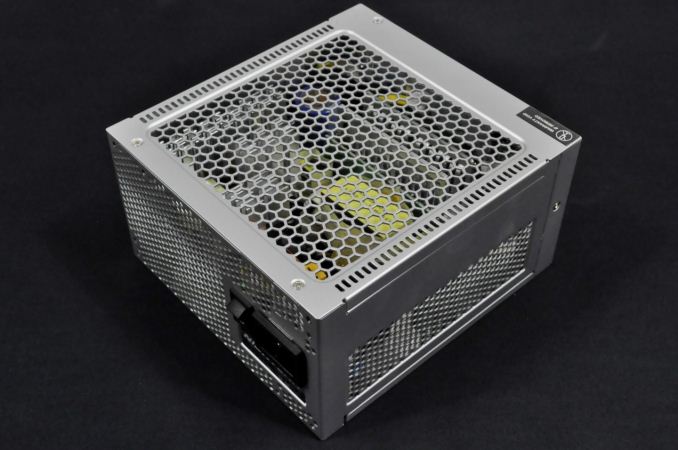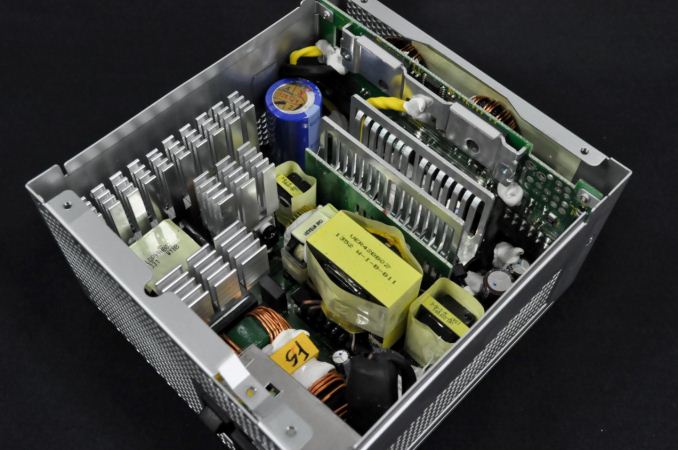SilverStone NightJar NJ520 Power Supply Review
by E. Fylladitakis on July 8, 2014 6:00 AM EST- Posted in
- Cases/Cooling/PSUs
- Seasonic
- PSUs
- Fanless
- SilverStone
External Appearance
In terms of size, the Nightjar NJ520 appears just like any other modular ATX PSU. Its silver chassis is 160mm deep, making it suitable for all ATX compliant cases. It is however noticeable that the PSU lacks a fan. The sides of the Nightjar NJ520 are perforated and, as the warning label indicates, the top side of the chassis has to be facing upwards when it is installed in a case, as the cooling scheme relies on convection via passive airflow. This will not be a problem for most modern tower cases, as they have a PSU compartment at or near their bottom; however, it will most certainly be an issue with tower cases that have the PSU compartment above the motherboard tray, or with most desktop/HTPC cases.
The front side of the chassis has even more openings for passive airflow, as well as the modular cable connectors. The connectors are black and there is a legend printed on the chassis, although they are keyed and you cannot install a cable into the wrong connector. The rear side is similar to that of any other ATX PSU, with an AC cable plug, a small switch and a metallic sticker with the series name beneath it.
Internal Design
After looking inside the Nightjar NJ520, we quickly identified that it is a Seasonic design, the one Seasonic is using for their own Platinum 520W Fanless model. There is a very strong filtering stage, partially shielded, consisting of six Y capacitors, three X capacitors and three filtering inductors. There is also a relay, which cuts off the AC supply to the unit entirely once it is turned off, to minimize losses while the system is powered off.
Despite the low output of the unit, there are two parallel rectifying bridges mounted on their own heatsink. The active APFC components, two transistors and a diode, are on the large heatsink near the edge of the PCB. The primary inversion stage consists of four switching transistors, forming a full bridge topology. The 12V conversion stage components are cooled by the U-type heatsink seen on the secondary side of the transformer. Only a 12V line is generated; the minor 3.3V and 5V lines are converted from it via DC-to-DC circuits that are on the connector's board.
A Hitachi 330μF / 420V capacitor is present for the APFC circuit. All of the secondary capacitors, electrolytic and polymer alike, are supplied by Nippon Chemi-Con. The quality of the soldering is very good, although not the best that we have seen and with a few hand-made joints. Glue is used to strengthen the unit mechanically, improving its reliability and reducing the chance of high frequency vibrations (coil whine noise).
























44 Comments
View All Comments
hybrid2d4x4 - Thursday, July 10, 2014 - link
Agree. I got a Seasonic 400 Platinum Fanless model to run an upper-midrange gaming rig/HTPC, and it never gets more stressed than 60% of its rated power (measured at the wall, not internally). Short of some picoPSU units with minimal power regulation, there isn't anything out there that's a good match for a 'typical' integrated video system and there should be!Cygni - Tuesday, July 8, 2014 - link
The more fanless/silent part reviews, the better. Maybe I'm just old now, but I refuse to have a big leaf blower of a computer in every room anymore, even for my gaming computer. It's 2014!Really interested in this part. Think it will go well with my new low heat gaming build. More silent/quiet reviews please!
Spoogie - Tuesday, July 8, 2014 - link
Not really sure I'd buy this over the Kingwin. I have the 1k version of the Kingwin and it's truly silent with no elec noise at all and a 5 year warranty.http://www.silentpcreview.com/Kingwin_Lazer_Platin...
johnny_boy - Tuesday, July 8, 2014 - link
Why don't they build "dual PSUs" that combines a low wattage psu (max 10W) with a higher wattage psu such that it switches to the low one when the computer is in standby and switches back to the higher wattage one when powered up. A standard desktop PSU must be massively ineffecient when powering a computer on standby.DanNeely - Tuesday, July 8, 2014 - link
I think VStandby is on a separate circuit; JonhyGuru does test it. Looking a pair of recent reviews, one that was slammed as the worst they'd seen in a long time was only ~70% efficient; but that's still only a few watts of wastage even at max load. And while I've never measured it, I'd expect standby power to be at the low end of the draw range except when you hit the power button and trigger the first part of the resume sequence or if you have and are using USB charging from an otherwise offline system.E.Fyll - Wednesday, July 9, 2014 - link
Because that would either increase the cost of the unit dramatically or result to a less efficient configuration. Besides, the difference between the least efficient and the most efficient PSU at standby is just a few cents per annum from an economic point of view. Improving the efficiency of the PSU at such low a load has zero actual purpose, therefore the companies are sticking to meeting the base guidelines rather than wasting resources and increasing the cost of their products to do that.lucyfek - Tuesday, July 8, 2014 - link
Does the fanless PSU really matter (besides for the pricetag)?Once you realize that decent PSU with 120mm slow fan is barely audible (definitely quieter than average CPU or GPU). Besides that you'll need to evacuate the heat out of the case somehow.
I did have 2 fanless PSU back in the day. Was my PC really quiet because of that - nope.
mapesdhs - Wednesday, July 9, 2014 - link
See my earlier post for a longer suitable reply, but basically, supposedly quiet PSUs
are usually not at all quiet, hybrid PSUs are poor quality, and heat rises. The PSU
I bought had a big label & notice inside making it very clear how it should be used
to ensure proper natural convective airflow.
Ian.
viharm - Wednesday, September 4, 2019 - link
Completely agree with @mapesdhs. I am following a similar path to my custom home NAS build.viharm - Wednesday, September 4, 2019 - link
It matters very much when you start taking other noisy parts out of the system. I am going fanless, so the PSU fan becomes the loudest part :-)